A Fast Terahertz Imaging Method Using Sparse Rotating Array
Abstract
:1. Introduction
2. The Proposed Imaging Scheme and Algorithm
2.1. Description of the Imaging Model
2.2. Analysis of the Spectral Support and PSF
2.3. Modified Imaging Algorithm
3. Optimization Method of Sparse Array
3.1. Array Optimization Method
3.2. Simulation Results for Array Design
4. Imaging Results and Analysis
5. Conclusions
Acknowledgments
Author Contributions
Conflicts of Interest
References
- Friederich, F.; Spiegel, W.; Bauer, M.; Meng, F.; Thomson, M.; Boppel, S.; Lisauskas, A.; Hils, B.; Krozer, V.; Keil, A.; et al. THz active imaging systems with real-time capabilities. IEEE Trans. Terahertz Sci. Technol. 2011, 1, 183–200. [Google Scholar] [CrossRef]
- Siegel, P. THz for space: The Golden Age. In Proceedings of the 2010 IEEE MTT-S International Microwave Symposium, Anaheim, CA, USA, 23–28 May 2010; pp. 816–819. [Google Scholar]
- Appleby, R.; Wallace, H. Standoff detection of weapons and contraband in the 100 GHz to 1 THz region. IEEE Trans. Antennas Propag. 2007, 55, 2944–2956. [Google Scholar] [CrossRef]
- Gollub, J.; Yurduseven, O.; Trofatter, K.; Arnitz, D.; Imani, M.; Sleasman, T.; Boyarsky, M.; Rose, A.; Pedross-Engel, A.; Odabasi, H.; et al. Large metasurface aperture for millimeter wave computational imaging at the human-scale. Sci. Rep. 2017, 20, 42650. [Google Scholar] [CrossRef] [PubMed]
- Sheen, D.; Mcmakin, D.; Hall, T. Three-dimensional millimeter-wave imaging for concealed weapon detection. IEEE Trans. Microw. Theory Tech. 2001, 49, 1581–1592. [Google Scholar] [CrossRef]
- Cooper, K.; Dengler, R.; Llombart, N.; Thomas, B.; Chattopadhyay, G.; Siegel, P. THz imaging radar for standoff personnel screening. IEEE Trans. Terahertz Sci. Technol. 2011, 1, 169–182. [Google Scholar] [CrossRef]
- Alexander, N.; Alderman, B.; Allona, F.; Frijlink, P.; Gonzalo, R.; Hägelen, M.; Ibáñez, A.; Krozer, V.; Langford, M.L.; Limiti, E.; et al. TeraSCREEN: Multi-frequency multi-mode Terahertz screening for border checks. Proc. SPIE 2014, 9078. [Google Scholar] [CrossRef]
- Venkatesh, S.; Viswanathan, N.; Schurig, D. W-band sparse synthetic aperture for computational imaging. Opt. Express 2016, 24, 8317–8331. [Google Scholar] [CrossRef] [PubMed]
- Ahmed, S.; Genghammer, A.; Schiessl, A.; Schmidt, L. Fully electronic active E-band personnel imager with 2 m2 aperture based on a multistatic architecture. IEEE Trans. Microw. Theory Tech. 2013, 61, 651–657. [Google Scholar] [CrossRef]
- Ahmed, S.; Schiessl, A.; Gumbmann, F.; Tiebout, M.; Methfessel, S.; Schmidt, L. Advanced microwave imaging. IEEE Microw. Mag. 2012, 13, 26–43. [Google Scholar] [CrossRef]
- Gonzalez-Valdes, B.; Alvarez, Y.; Mantzavinos, S.; Rappaport, C.; Las-Heras, F.; Martinez-Lorenzo, J. Improving security screening: A comparison of multistatic radar configurations for human body imaging. IEEE Antennas Propag. Mag. 2016, 58, 35–47. [Google Scholar] [CrossRef]
- Moulder, W.; Krieger, J.; Majewski, J.; Coldwell, C.; Nguyen, H.; Maurais-Galejs, D.; Anderson, T.; Dufilie, P.; Herd, J. Development of a high-throughput microwave imaging system for concealed weapons detection. In Proceedings of the 2016 IEEE International Symposium on Phased Array Systems and Technology (PAST), Waltham, MA, USA, 18–21 October 2016; pp. 1–6. [Google Scholar]
- Soumekh, M. Synthetic Aperture Radar Signal Processing with MATLAB Algorithms; Wiley-Interscience: Malden, MA, USA, 1999. [Google Scholar]
- Soumekh, M. Reconnaissance with slant plane circular SAR imaging. IEEE Trans. Image Proc. 1996, 5, 1252–1265. [Google Scholar] [CrossRef] [PubMed]
- Rappaport, C.; Gonzalez-Valdes, B.; Allan, G.; Martinez-Lorenzo, J. Optimizing Element Positioning in Sparse Arrays for Near Field MM-Wave Imaging. In Proceedings of the 2013 IEEE International Symposium on Phased Array Systems & Technology, Waltham, MA, USA, 15–18 October 2013; pp. 333–335. [Google Scholar]
- Baccouche, B.; Agostini, P.; Mohammadzadeh, S.; Kahl, M.; Weisenstein, C.; Jonuscheit, J.; Keil, A.; Loffler, T.; Sauer-Greff, W.; Urbansky, R.; et al. Three-dimensional Terahertz imaging with sparse multistatic line arrays. IEEE J. Sel. Top. Quant. 2017, 23, 1–11. [Google Scholar] [CrossRef]
- Bryant, M.; Gostin, L.; Soumekh, M. 3-D E-CSAR imaging of a T-72 tank and synthesis of its SAR reconstructions. IEEE Trans. Aerosp. Electron. Syst. 2003, 39, 211–227. [Google Scholar] [CrossRef]
- Ponce, O.; Prats-Iraola, P.; Pinheiro, M.; Rodriguez-Cassola, M.; Scheiber, R.; Reigber, A.; Moreira, A. Fully polarimetric high-resolution 3-D imaging with circular SAR at L-band. IEEE Trans. Geosci. Remote Sens. 2014, 52, 3074–3090. [Google Scholar] [CrossRef]
- Greengard, L.; Lee, J. Accelerating the nonuniform fast Fourier transform. SIAM Rev. 2004, 46, 443–454. [Google Scholar] [CrossRef]
- Gao, J.; Deng, B.; Qin, Y.; Wang, H.; Li, X. Efficient Terahertz wide-angle NUFFT-based inverse synthetic aperture Imaging considering spherical wavefront. Sensors 2016, 16, 2120. [Google Scholar] [CrossRef] [PubMed]
- Cumming, I.; Wong, F. Digital Processing of Synthetic Aperture Radar Data: Algorithms and Implimentation; Artech House Publishers: London, UK, 2005. [Google Scholar]
- Li, X.; Liu, G.; Ni, J. Autofocusing of ISAR images based on entropy minimization. IEEE Trans. Aerosp. Electron. Syst. 1999, 35, 1240–1252. [Google Scholar] [CrossRef]
- Yang, L.; Xing, M.; Zhang, L.; Sheng, J.; Bao, Z. Entropy-based motion error correction for high-resolution spotlight SAR imagery. IET Radar Sonar Navig. 2012, 6, 627–637. [Google Scholar] [CrossRef]
- Sun, Z.; Li, C.; Gao, X.; Fang, G. Minimum-entropy-based adaptive focusing algorithm for image reconstruction of terahertz single-frequency holography with improved depth of focus. IEEE Trans. Geosci. Remote Sens. 2015, 53, 519–526. [Google Scholar]
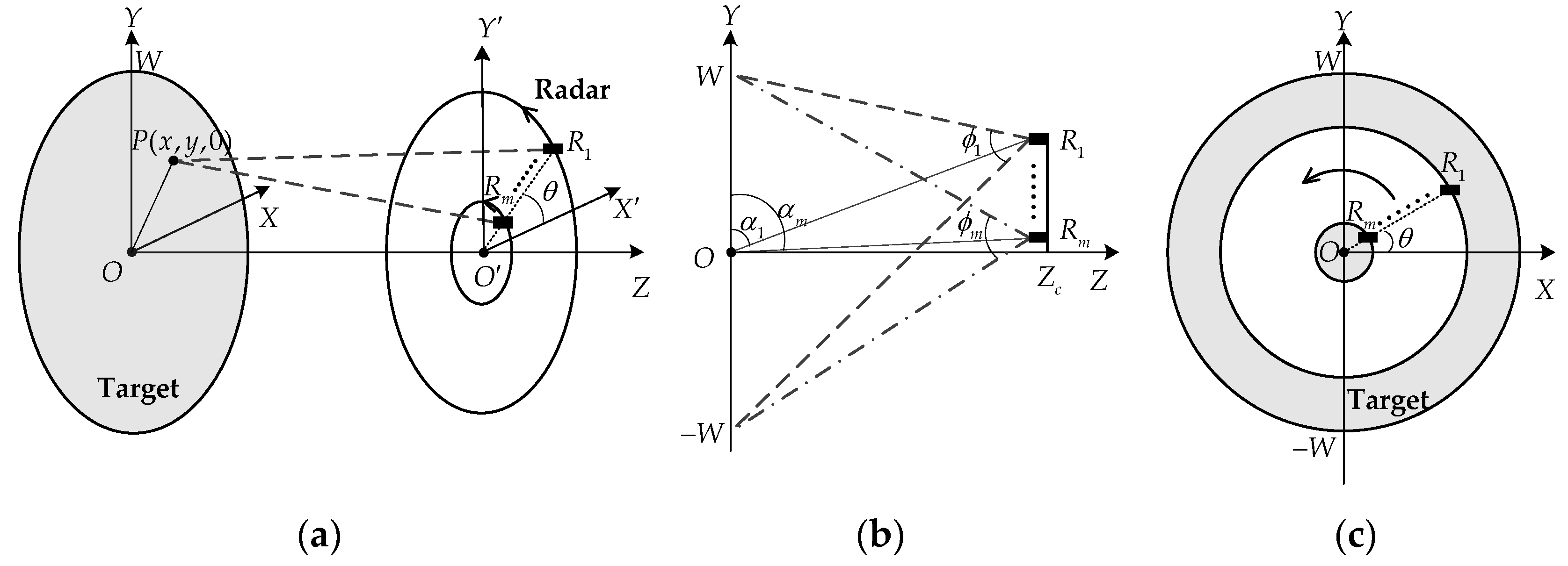
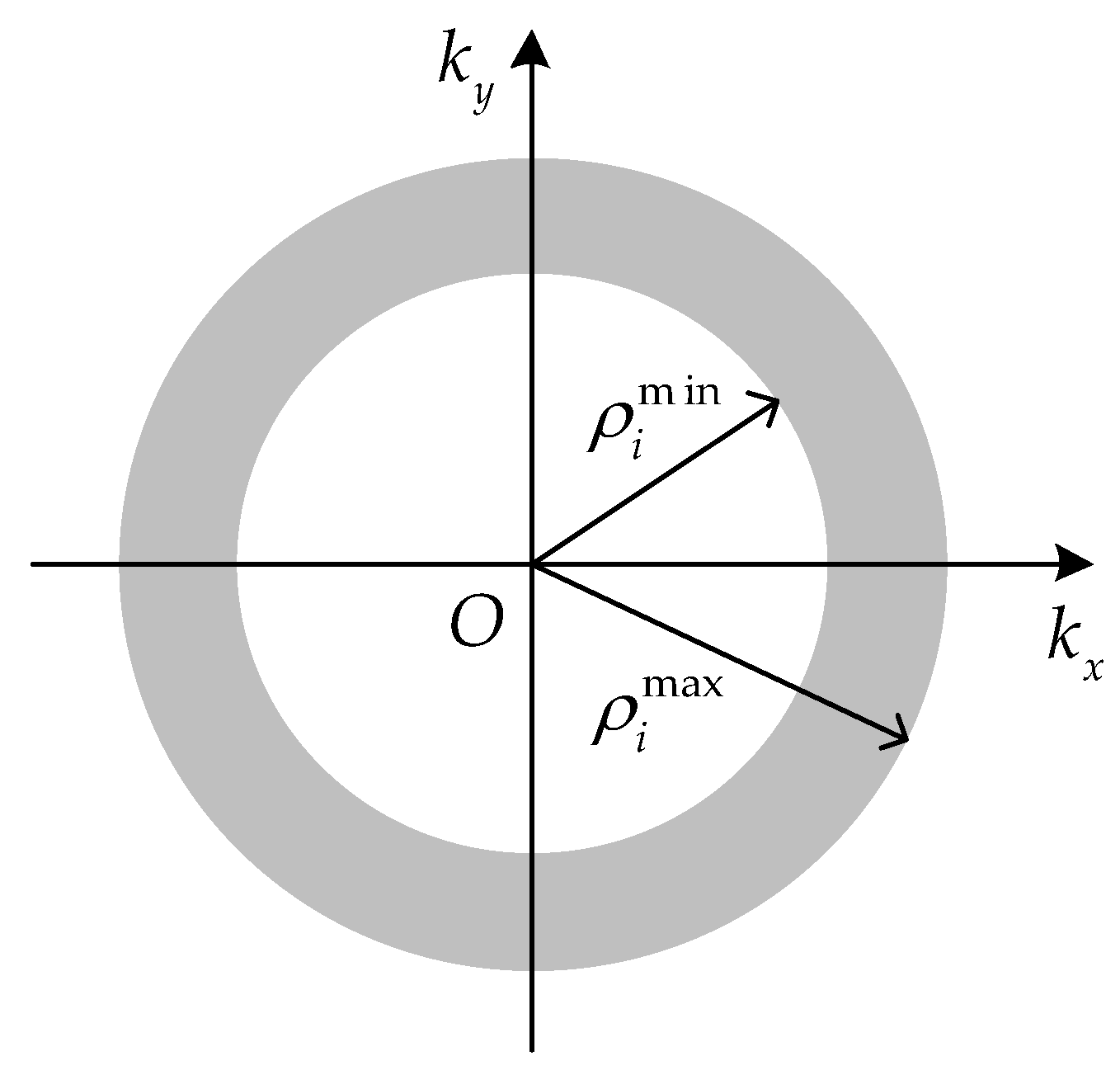
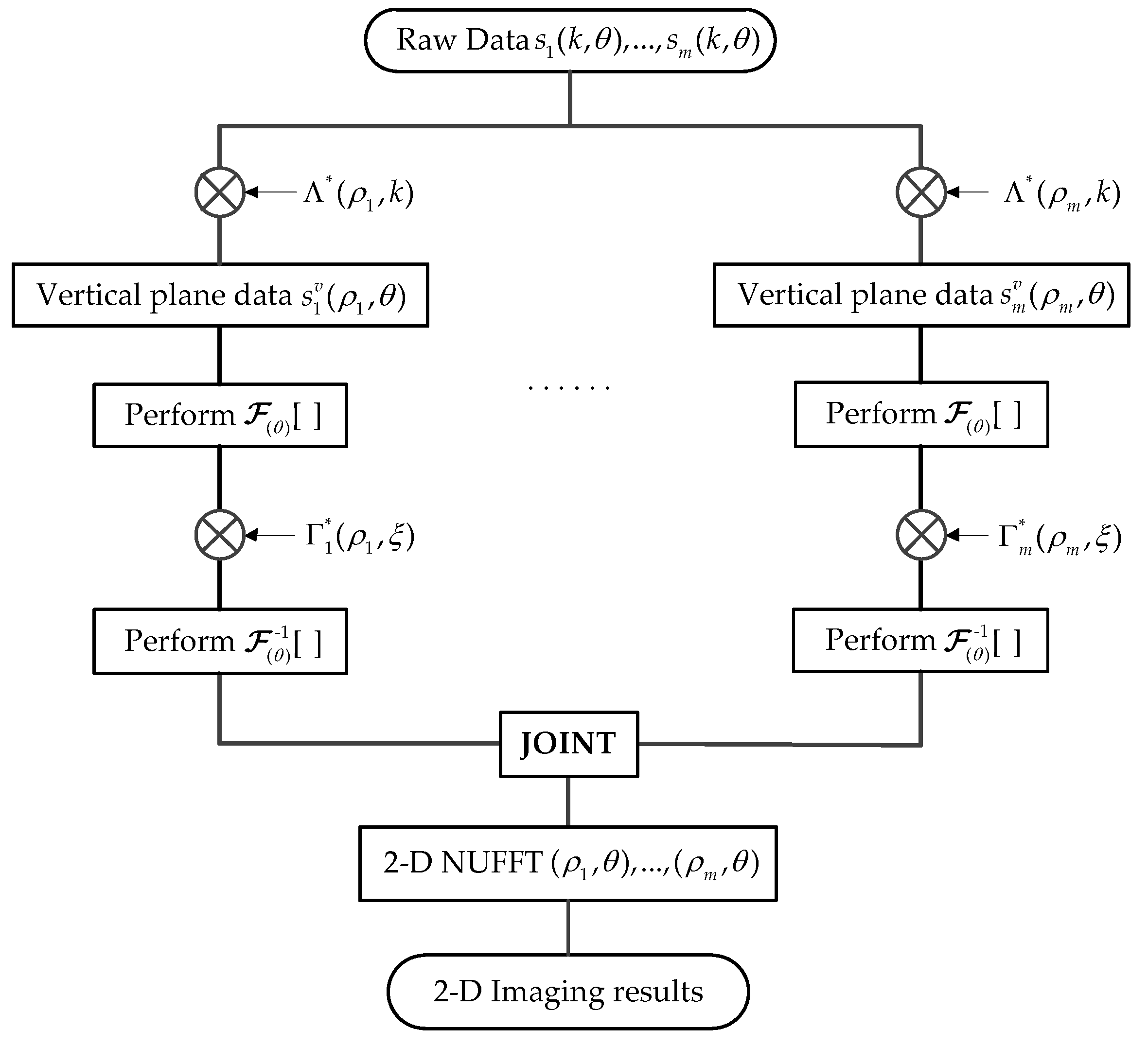
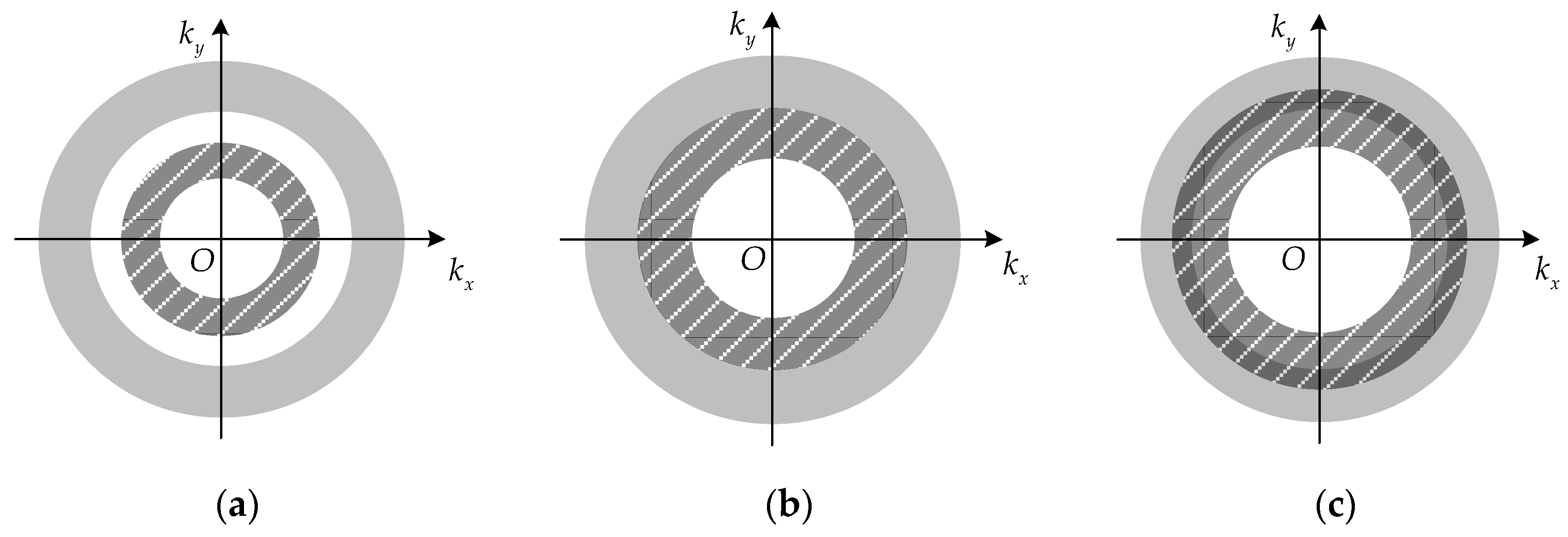


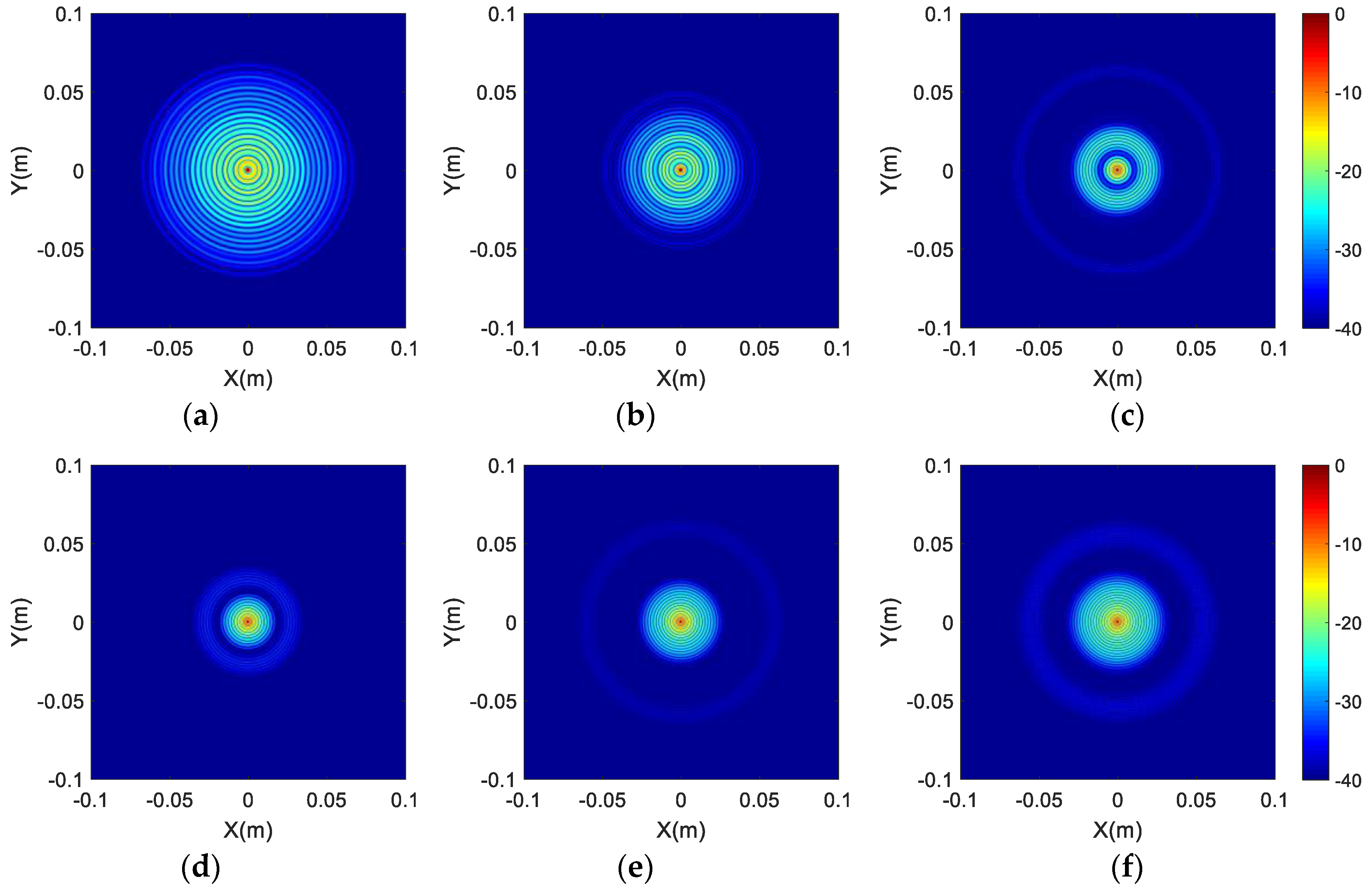
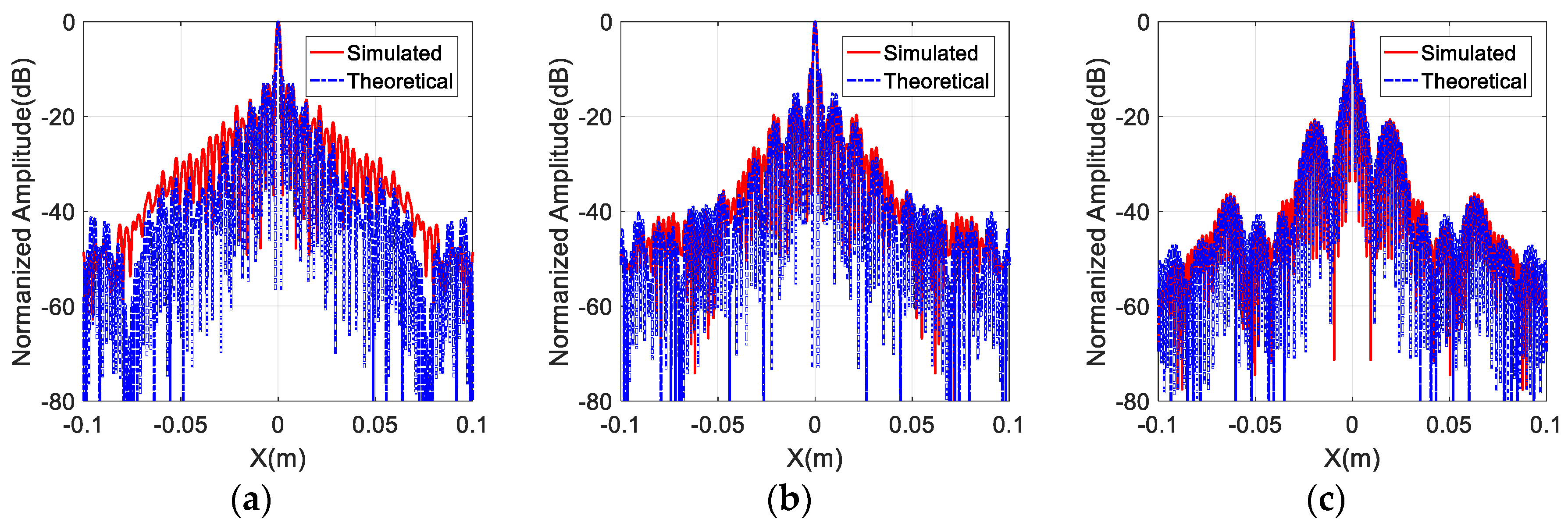
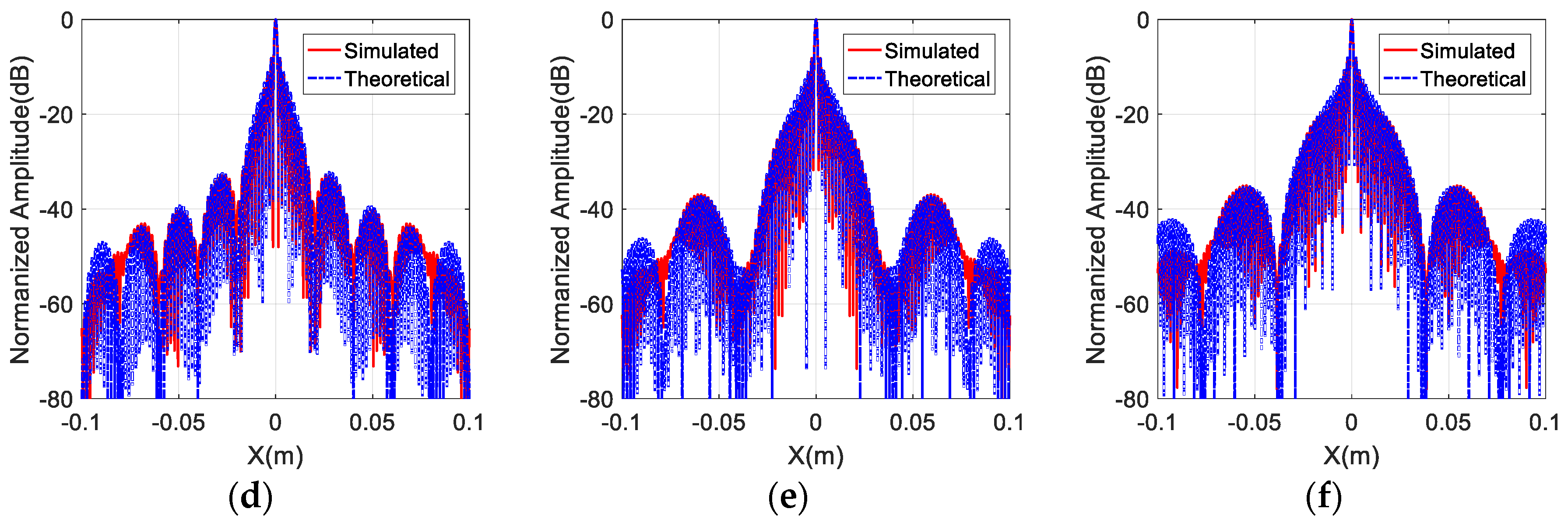

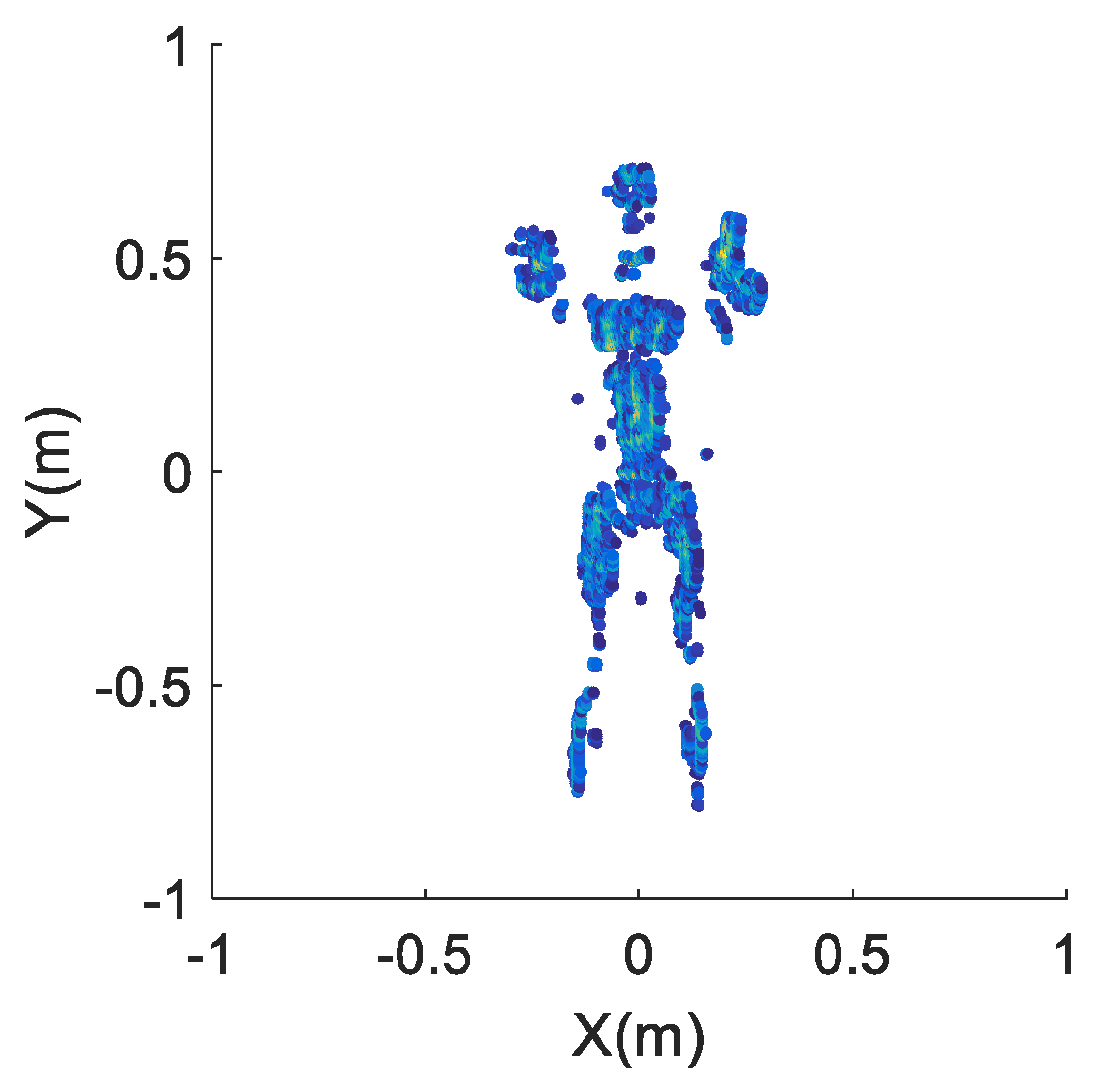

| Parameters | Numerical Value |
|---|---|
| Center frequency | 220 GHz |
| Bandwidth | 20 GHz |
| Maximum radius of antenna | 0.6 m |
| Horizontal range | 3 m |
| Imaging scene radius | 1 m |
| Sampling interval of | 0.01 GHz |
| Sampling interval of | 0.1° |
| Sampling numbers of frequency | 2001 |
| Sampling numbers of azimuthal angle | 3600 |
| No. | Type I | Type II | Type III | Type IV | Type V | Type VI |
|---|---|---|---|---|---|---|
| (m) | 0.6 | 0.6 | 0.6 | 0.6 | 0.6 | 0.6 |
| (m) | 0.3 | 0.4 | 0.5 | 0.546 | 0.57 |
| No. | Type I | Type II | Type III | Type IV | Type V | Type VI |
|---|---|---|---|---|---|---|
| Area percentage | 16.43% | 18.99% | 22.24% | 23.95% | 19.22% | 13.06% |
| ISLR (dB) | 9.0674 | 7.5736 | 7.3180 | 6.7343 | 8.4933 | 9.9953 |
| Image entropy | 12.8088 | 12.0532 | 11.3908 | 10.5492 | 11.1750 | 11.7455 |
| IRW (m) | 0.0019 | 0.0017 | 0.0015 | 0.0013 | 0.0013 | 0.0013 |
© 2017 by the authors. Licensee MDPI, Basel, Switzerland. This article is an open access article distributed under the terms and conditions of the Creative Commons Attribution (CC BY) license (http://creativecommons.org/licenses/by/4.0/).
Share and Cite
Jiang, Y.; Deng, B.; Qin, Y.; Wang, H.; Liu, K. A Fast Terahertz Imaging Method Using Sparse Rotating Array. Sensors 2017, 17, 2209. https://doi.org/10.3390/s17102209
Jiang Y, Deng B, Qin Y, Wang H, Liu K. A Fast Terahertz Imaging Method Using Sparse Rotating Array. Sensors. 2017; 17(10):2209. https://doi.org/10.3390/s17102209
Chicago/Turabian StyleJiang, Yanwen, Bin Deng, Yuliang Qin, Hongqiang Wang, and Kang Liu. 2017. "A Fast Terahertz Imaging Method Using Sparse Rotating Array" Sensors 17, no. 10: 2209. https://doi.org/10.3390/s17102209





